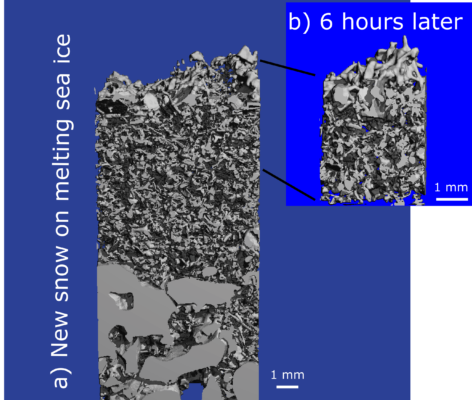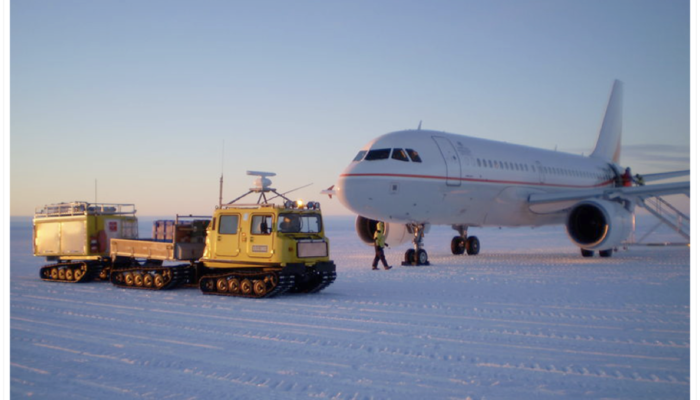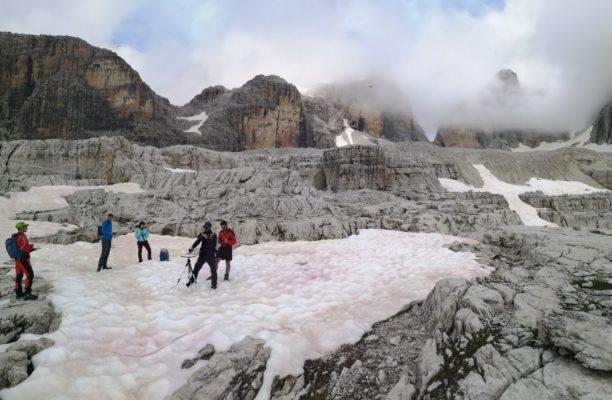Sastrugi are significant features in glaciology, providing valuable insights into wind patterns, snow dynamics, and surface processes. So although at first sight they may be easy to walk over (quite literally), their patterns and features can tell us more than you might think, so next time take a moment to look and see the story they have to tell… The Song of Sastrugi The wind’s icy b ...[Read More]
The joy of collecting snow meltwater: a problem-solving hunt for meltwater in Northern Finland
We know that climate change is affecting many aspects of what we have considered “stable” throughout a long period of modern times. One of many impacted and changing factors is snow and thereby also snow meltwater. One way to study meltwater is to trace it by the usage of stable water isotope signals and we plan to use it by asking: Are we underestimating the portions of snow meltwater in differen ...[Read More]
End-of-the-year special: this year’s Cryoblog
So this is the last post in 2022 for our blog. We have decided that this time, the topic will not be another exciting story about the science of ice and cold in their various forms. This time we are talking about the blog itself, so a kind of meta-post to take stock and understand a little better how our blog works, what it is about, and who our main authors are. To this purpose, we asked all the ...[Read More]
Did you know that snow is hot?

When I was a student, Martin told me matter-of-factly that snow is hot. I probably looked as baffled as I felt (and you are probably doing the same). Were we talking about the same thing? Continue reading to discover why snow is hot! Discovering that snow is hot So why is snow hot? Most snow under Earth’s environmental conditions has a homologous temperature Th close to 1. The homologous temperatu ...[Read More]
What are Snow Mechanics and why should we care?

Every time we walk, ski, drive or build upon snow, we’re relying upon the theory of Snow Mechanics; but what is that and why should we care? Mechanics is the engineering terminology used to describe “the branch of applied mathematics dealing with motion and forces producing motion” (Oxford Languages) or more simply, the study of motion, in our case the motion of snow. What causes snow to move? Ge ...[Read More]
Ice-hot news: A cryo-summary of the new IPCC assessment report!

We have waited eight years for it, and it is finally out: the 6th Assessment Report of the Intergovernmental Panel on Climate Change (a.k.a. « IPCC AR6 »)! And it is more than 10,000 pages long across Working Groups! Fortunately, a synthesis report integrating the findings of all three working groups should be released in Autumn 2022. However, we, at the EGU Cryosphere Blog, thought it might be us ...[Read More]
Cryo-Adventures – Hunting snow algae in the Alps

We are used to think of algae as marine or lacustrine organisms, but they are actually able to thrive also on the cryosphere. In a previous post, we learnt how snow algae live and reproduce on snow. Now we will explore how and why scientists study snow algae, and how social media can be used for identifying new study areas. Snow algae in the Alps Snow algae in the Alps have been overlooked or conf ...[Read More]
On snowmelt, water security, and a warming climate – Why solution-oriented research matters, now more than ever
1 April 2015: for the first time on record, the chief of the California Cooperative Snow Surveys, Frank Gehrke, had no snow to measure at the Phillips Snow Course near Lake Tahoe at the end of the winter. This was in some ways unsurprising, as California had been in a drought since 2012. But drought was nothing new in the state, and this was the first time on record that snow was completely absent ...[Read More]
Image of the Week – What darkens snow and ice?
“Be thou as chaste as ice, as pure as snow”. Hamlet, Act 3 Scene 1 (W. Shakespeare) Snow and ice are not always as pristine as one may think. If you have ever walked on a glacier or on a snowfield during summer, you might have already noticed that. In fact, both snow and ice are often darkened by impurities. In this blog post, you will learn about the main processes leading to ice and snow darkeni ...[Read More]
Ice-hot news: The IPCC Special Report on the Oceans and the Cryosphere under Climate Change

You have probably heard the name “Intergovernmental Panel on Climate Change (IPCC)” mentioned frequently over the last few years. The IPCC is the United Nations body for assessing science related to climate change and it publishes global assessment reports on this topic every 5 to 10 years. Due to the current urgency of the global climate crisis and the need for more information by decision makers ...[Read More]



